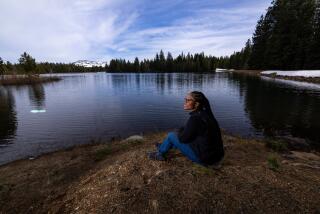English Protest Development of Green Belts
- Share via
LANGLEY BOTTOM, England — It’s William Blake’s “green and pleasant land,” an expanse of emerald hills speckled with sheep, the tiled roofs and church spire of a sleepy village glowing in the sun.
But these days, the placid Langley Valley about 30 miles north of London is plastered with incongruous signs in bold red lettering: “Say No to 10,000 Houses” and “Save the Green Belt.”
In the kitchen of her 17th century timber-framed house in Langley Bottom, Barbara Ackroyd gazes despairingly at a large map detailing the Stevenage Borough Council’s development plan. It wants to cram rows of new homes, playing fields, stores and at least seven schools onto 1,500 pastoral acres of the valley.
“We have to fight it. This land is precious,” said Ackroyd, who with her lawyer-husband, Tim, runs the Campaign Against Stevenage Expansion.
The group sees itself at the cutting edge of a battle to save Britain’s dwindling rural areas, part of a wider fight to prevent “townies” from destroying the country lifestyle.
Much debate has focused on attempts by a Labor Party lawmaker to pass legislation that would outlaw hunting with hounds, a country staple. Farmers also accuse the government of hobbling the beef industry by causing a panic over “mad cow” disease.
At a recent rally, more than 2,000 people marched through the fields in the rain to protest the Stevenage council’s development plans for the Langley Valley.
The council says it is hesitant to despoil the area, but argues the region will need an additional 9,700 homes by 2011 for the growing number of single residents, broken families and youngsters leaving home earlier.
For more than 50 years, British planning policy has been to encircle towns and cities with undeveloped land--”green belts”--to cushion the countryside against urban sprawl and provide “green lungs” for towns.
John Prescott, Britain’s deputy prime minister and environment secretary, said earlier this year that the new Labor government aims for “an urban renaissance” and “ensuring a green and pleasant land.”
The government’s new planning code states that “the essential characteristic of the green belts is their permanence. . . . Boundaries should be altered only in exceptional circumstances.”
But for a small island with a population that has risen nearly 60% this century, to 60 million--the bulk of them living in the south--there is unremitting pressure for new housing. The Department of the Environment says 4.4 million new homes will be needed in Britain by 2016.
To ease the pressure, Prescott has begun a study into the feasibility of regenerating “brownfield sites”--derelict land in urban areas.
He hopes the proportion of new houses built on such sites across Britain will rise to 60% over the next 10 years. Currently, as few as 30% of new homes are built on brownfield sites in many places, although the figure is about 85% in crowded London.
But while government workers gather information, the Council for the Protection of Rural England says other local authorities will be following Stevenage’s expansionist lead.
The group notes that, going against the recommendations of its own advisors, the government gave permission in August for a major development on 150 acres of green belt at Peddimore in central England.
The month before, the government approved the start of work on a major new highway through 1,500 acres of green belt north of Birmingham in central England.
The government counters that despite losses of some green belt land to development, planning changes over the last year have resulted in a net increase of around 9,000 acres of such lands.
The Ackroyds’ group says the Langley Valley development would be the largest loss of green land since Stevenage and other “new towns” were built in the 1950s to absorb people from bomb-damaged London.
The Ackroyds argue that the plan would destroy vital natural habitats and an important hiking trail, swamp ancient villages and strain roads, water supplies and sewage facilities.
It also would unite sprawling Stevenage with Hitchin, a pretty market town of 30,000 people eight miles away that was founded in medieval times.
“It will overpower the whole area,” said Bill Bowker of the community group Hitchin Forum. “There is an enormous amount of open space in Stevenage that could be intelligently developed.”
The Campaign Against Stevenage Expansion has sent 7,000 protest postcards to Prescott, the deputy prime minister who has the final say on whether to block the Langley Valley development.
The protesters include Roy Pearce, landlord of The Greyhound pub in Hitchin. Extra homes mean extra business for him--but he doesn’t care.
“I grew up around here, and I consider myself a country person,” he said. “This development will destroy wildlife and increase traffic and spoil a beautiful area.
“It would be a desecration,” he said.
More to Read
Sign up for Essential California
The most important California stories and recommendations in your inbox every morning.
You may occasionally receive promotional content from the Los Angeles Times.













